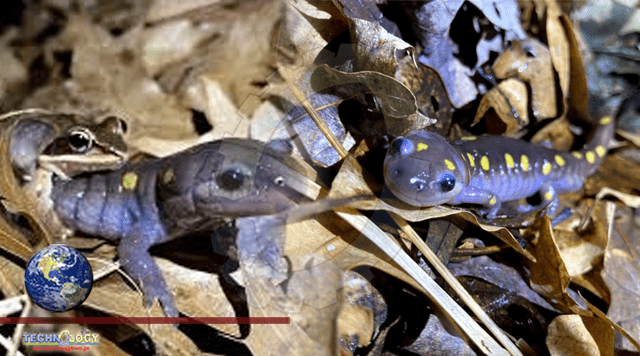The Appalachian region of the US has more types of salamanders than anywhere else in the world; 40% of them are threatened.

By Jeff St. Clair
Life is returning to Ohio woodlands as winter gives way to warmer weather.
Creatures that for months slumber underground are now seeking spots to breed in an ancient rite of renewal.
We head out into the woods in search of the elusive harbingers of spring.
Here are a few tips for successfully spotting a migrating salamander, according to Summit Metro Parks naturalist Becca Zak.
“It has to be dark,” she said. “It can’t be windy, and it has to be actively raining at about 50 degrees.”
There’s a feeling in the air when conditions are right.
“It’s my favorite time of year,” said Zak.
My sons and I went out on a recent evening in early March that was close to perfect, except the rain had stopped.
We trekked through a remote Summit County woods bordered by a busy interstate.
In the distance, a sweet chorus cut through the roar of the highway.
Spring peepers, tiny frogs about the size of a quarter, sang backup to the raucous quacking of amorous wood frogs, spring’s earliest arrivals.
The frogs splashed in a muddy puddle turned woodland nursery
in a passionate romp to celebrate the end of winter.
Salamanders brief time above ground
We spy one frog gripping a rather unwilling partner, a male spotted salamander.
Zak sees these shy amphibians each spring in Sand Run Metro Park.
“They’re about the size of a hotdog with a really nice, wide smile which makes them super cute,” she said.
Two rows of bright yellow spots line its blueish black body, glowing in the dim light.
Just a handful of male salamanders ventured out the night we were out, the females apparently had the sense to await more rain.
These mole salamanders are only seen during their brief spring courtship, spending the remaining 11 months of the year underground feeding on worms and insects.
A fungal invasion
Our next stop was northern Portage County.
Here we met Hiram College biology professor Jenn Clark and her students who are counting amphibians caught in special traps near the school’s field station.
Henry Schwendler, an environmental studies student at Hiram, scoops up a dark gray salamander.
“We got a Jefferson’s,” he said.
(At least he guessed it was a Jefferson salamander. Identifying some species can get tricky as this video explains.)
It’s part of a survey of several puddles, large ruts leftover from an old logging road, where they monitor the emergence of woodland amphibians.
Another Hiram student, Zack Fox reads the total from one pool, “sixty-eight wood frogs, fifty-two Jefferson’s, and one red-spotted newt,” he tallied.
Clark tested several animals for a fungal infection that in other parts of the world has wiped out populations of rare frogs.
“We’re trying out a new method to swab amphibians for chytrid that may or may not work,” she acknowledged.
Keegan Rankin, another of Clark’s students, explained how the fungus grows on the frogs’ skin causing them to suffocate.
“And you’ll see in certain species that get infected, their skin becomes thick and leathery, and often turns red,” said Rankin.
“So if you see a lot of dead frogs in your area with red legs it’s a sign of the presence of chytrid.”
After the count, Rankin dumped the critters back in the pool.
Clark will send the swabs to a California lab to determine how widespread the fungus is in Hiram. In a previous survey in Geauga County she found it in every sample she collected.
The ultimate survivors
“They’ve been around for millions of years and have lived through ice ages, heat waves, droughts and floods.”
Greg Lipps is the amphibian and reptile conservation coordinator at Ohio State University, and coauthor of The Amphibians of Ohio.
He said amphibians have managed to live through all of these upheavals over the eons, but now their populations around the world are declining.
“That’s very worrisome,” said Lipps.
The fungus is the reason he said, “but by far the largest threat and the biggest driver in the loss of biodiversity, both in Ohio and throughout the world, is the loss of habitat.”
Vernal pools and small wetlands have virtually no protection from development other than aggressive land conservation.
Four of Ohio’s 25 salamander species are endangered, including the massive and extremely rare Hellbender, which reaches two feet long.
The Appalachian region of the US has more types of salamander than anywhere else in the world; 40% of them are threatened.
An age-old question
For tens of thousands of years salamanders have been waking up in the spring and marching to breeding pools along Sand Run in Akron.
In recent years it’s been a big draw for people wanting to witness the annual migration.
Metro Parks naturalist Becca Zak says this year’s public event is cancelled due to COVID, but they had a virtual presentation to answer the age-old question: “They cross the road because they’re going somewhere,” said Zak.
“They really do need to get to the other side.”
Originally published at Wksu